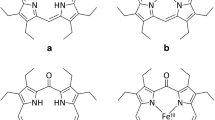Abstract
The analysis of Co(II)-apoHc complexes of two arthropodan species (freshwater crayfish): Orconectes limosus and Astacus astacus enabled to reach some conclusions about possible cobalt binding sites in the hemocyanin molecules. The occurrence of binding sites for Co(II) at sites other than the active center has been demonstrated. We excluded the possibility of strong binding of EDTA-non-removable cobalt ions in the binding sites occupied by copper. There were no differences between apoHc and the Co(II)apoHc complex in terms of the amount of bound Cu(I) ions and the kinetics of Cu(I) ion reconstitution.
Similar content being viewed by others
Abbreviations
- He:
-
hemocyanin
- apoHc:
-
apohemocyanin
- oxyHc:
-
oxyhemocyanin
- Co-Hc:
-
hemocyanin complex with cobalt ions
References
Belleli A, Zolla L, Giordani B, Costantini S, Cau A, Brunori M (1985) Hemocyanin from Palinurus elephas: general properties and effect of heavy metals. Biochim Biophys Acta 830: 325–331
Brouwer M, Engel DW (1982) Stoichiometry and functional consequences of Hg(II) and Cd(II) binding to arthropod hemocyanins. In: Physiological mechanism of marine pollutant toxicity. Academic Press, New York, pp 289–310
Gondko R, Michalak W (1981) Some physicochemical properties of hemocyanin of crayfish. In: Lamy J, Lamy J (eds) Invertebrate oxygen-binding proteins. Dekker, New York, pp 41–47
Gondko R, Serafin E, Mazur J, Jeowska-Trzebiatowska B, Jezierski A (1985) The kinetics of the reaction of thiocyanate and nitrite ions with Orconectes limosus oxyhemocyanin. Z Naturforsch 40c: 44–48
Himmelwright RS, Eickman NC, Lu Bien CD, Solomon EI (1980) Chemical and spectroscopic comparison of the binuclear copper active site of mollusc and arthropod hemocyanins. J Am Chem Soc 102: 5378–5388
Jones RD, Summervile DA, Bosolo F (979) Synthetic oxygen carriers related to biological systems. Chem Rev 79: 139–179
Konings WN, Van Driel R, Van Bruggen EFJ, Gruber M (1969) Structure and properties of hemocyanins. V. Binding of oxygen and copper in Helix pomatia hemocyanin. Biochim Biophys Acta 194: 55–60
Lorosch J, Haase J (1986) Cobalt(II)-Hemocyanin: Model for the cuprous deoxy protein giving evidence for a bridging ligand in the active site. Biochemistry 25: 5850–5857
Salvato B, Beltramini M, Piazzesi A, Alvigi M, Ricchelli F (1986) Preparation, spectroscopic characterization and anion binding studies of a mononuclear Co(H) derivative of Carcinus maenas hemocyanin. Inorg Chim Acta 125: 55–62
Suzuki S, Kino J, Kimura M, Mori N, Nakahara A (1982a) Structure of the active site of hemocyanin. Cobalt (II)-substituted squid hemocyanin. Inorg Chim Acta 66: 41–47
Suzuki S, Kino J, Nakahara A (1982b) Cobalt(II)-substituted horseshoe crab hemocyanins. Bull Chem Soc Jpn 55: 212–217
Witters R, Lontie R (1975) The formation of Helix pomatia methaemocyanin accelerated by azide and fluoride. FEBS Lett 60: 400–403
Witters R, Lontie R (1983) Characterization of cobalt-substituted haemocyanin of Helix pomatia. Life Chem Rep [Suppl] 1: 285–288
Author information
Authors and Affiliations
Additional information
Offprint requests to: E. Serafln
Rights and permissions
About this article
Cite this article
Serafin, E., Gondko, R. Does cobalt really bind tightly to hemocyanin active sites?. Eur Biophys J 18, 117–120 (1990). https://doi.org/10.1007/BF00183270
Received:
Accepted:
Issue Date:
DOI: https://doi.org/10.1007/BF00183270




